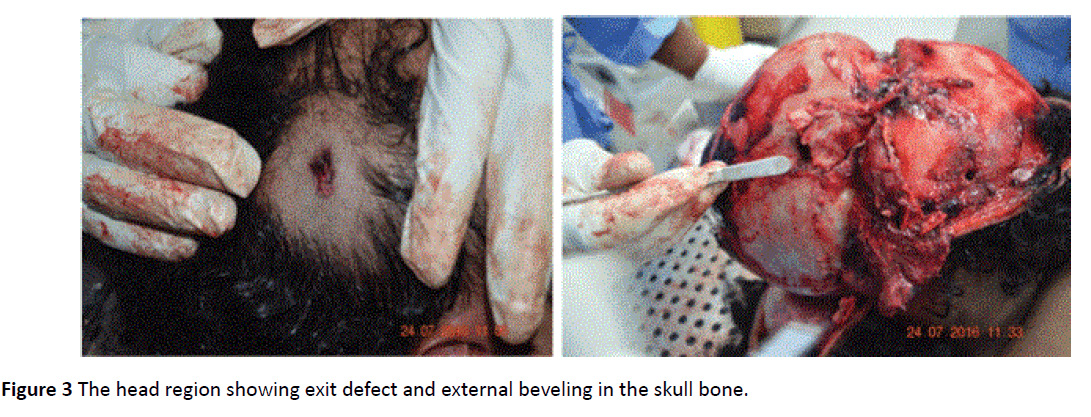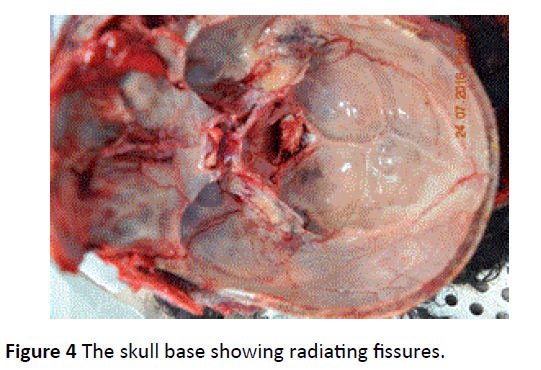Medico Legal Autopsy of an Atypical Firearm Skull Inlet: A Case Report
Samah F Ibrahim and Mohamed Mahdi
DOI10.21767/2471-9641.100022
Samah F Ibrahim1 and Mohamed Mahdi2
1Department of Forensic Medicine and Clinical Toxicology, Princess Nourah Bint Abdulrahman University, Riyadh, Kingdom of Saudi Arabia
2Forensic Medicine Center, Riyadh, Kingdom of Saudi Arabia
- *Corresponding Author:
- Samah F Ibrahim
Department of Forensic
Medicine and Clinical Toxicology Princess
Nourah Bint Abdulrahman University Riyadh
King Saudi Arabia
Tel: 009660547669095
E-mail: samahibraheem@yahoo.com
Received date: November 19, 2016; Accepted date: January 03, 2017; Published date: January 10, 2017
Citation: Ibrahim SF, Mahdi M. Medico Legal Autopsy of an Atypical Firearm Skull Inlet: A Case Report. Med Toxicol Clin Forens Med. 2017, 3:1.
Abstract
Firearm injuries contribute to considerable morbidity and mortality. The ricocheting bullet is a high-velocity bullet after interacting with intermediate object. Ricocheting bullet produces a unique wound, its mechanics have been discussed from time to time. The case presented an atypical presentation of firearm entrance w ound, wher e the en tr y wound situated on left temporal skull region with surrounding abrasions in addition the bullet entered the cranial cavity to cause an exit fracture defect situated on right temporal skull region with brain disruption. Our case emphasizes that forensic doctors should carefully interpret the properties of atypical firearm entry wound.
Introduction
The incidence of firearm injuries is increasing worldwide, particularly those involving the head. The head contains vital structures and the smallest movement by a penetrating missile may easily injure them. Therefore the leading cause of death will be brain injury [1]. Firearm injuries have both inlet and exit wounds that can be differentiated from each other according to their specific features that they pose on skin and bone [2].
Interesting ballistic wounds are affected by many factors e.g. magnitude of energy transferred, distance travelled by the bullet, type of bullet, and the structures encountered before and on penetration. Inflicted damage is proportional to the energy transferred from the missile to the tissues, where the bullet may have one of the following impacts: direct bullet (hit), indirect bullet (ricocheting) or a ‘falling’ bullet [1-3]. Therefore, all of these factors should be considered in any firearm wound examination to differentiate the inlet from the exit and to estimate the range of firing [4].
This study reported an atypical firearm inlet wound pattern that was observed in a distant range homicidal gunshot seen on the left temporal region with resultant brain injury.
Case Report
A 19 year old Saudi male was presented to the Forensic Medicine Center in Riyadh following a homicidal firearm injury to the left side of his head leaving a large open defect.
A body of a young person was found dead inside a car with a bleeding injury in his head. Eye witness informed the police that the car was shot by an automatic weapon from its left side from distance more than 4 m. The investigating authorities found that 27 bullets in the scene, 19 bullets hit the left side of the car, 3 penetrated the car and had direct relation to the dead body. In addition fine, small and medium sized glass particles were found around the victim. He was a rear seat passenger and was found dead in a sitting position with a fatal firearm wound in the left side of his head. His hair and upper part of the face were soaked with blood (Figure 1).
On examination, worn clothes (jallabeyah, t-shirt and underpants) were heavily stained with blood in almost all aspects without any suspicious cuts or tears. The whole body was intact except for a large defect in the left temporal region where part of the scalp and underlying temporal bone were lost. Finely powdered glass particles were visualized on the skin and the hair.
On close examination of this defect, the inlet was found as an irregular wound starting from the left temporal region and extending to the frontal region, 10 cm in front of the left ear with lacerated, abraded and ragged margins-size 8 × 6 cm. These margins were not surrounded by blackening, burning or tattooing, but were surrounded by multiple irregular abrasions extending to the left parietal region (Figure 2).
Wound track was traced and was found to be directed upwards and forwards resulting in a defect in the right temporal bone 11 cm away from the midline and just in front of the right ear with a star-shaped wound in the scalp-size 2 × 1.5 cm. This defect represented the exit wound. The whole reconstructed track showed bloody red discoloured soft tissues and muscles (Figure 3).
The inlet showed internal beveling (Figure 2) with multiple radiating fractures extended to middle cranial fossa (Figure 4) while the exit showed external beveling (Figure 3). The brain substance was severely lacerated and disrupted. This traumatic brain injury due to fatal gunshot wound to the head was reported as a cause of death in this case.
Discussion
Gunshot injuries are a major problem especially in Saudi Arabia; they affect victims seriously [5]. These injuries need accurate evaluation especially in presence of atypical presentations either in inlet or exit wounds [4].
Weapons, ammunition, mechanism of sustaining a wound and wound site on the body may alter the appearance of gunshot inlets [6]. Inflicted damage is proportional to the energy transferred to the tissues. Direct ‘hit’ impact is expected to have an entry wound that is small, with a shape and diameter of the missile whereas a ‘broadside-on’ direct ‘hit’ tends to be more ragged with an irregular pattern. These are basically high-energy transfer injuries. A ‘falling’ bullet would be low-energy transfer in nature as it is limited to the influence of gravity and its entry wound has any size and shape [7]. A destabilized bullet creates atypical gunshot inlet as it enters the body at an angle or sideways. It commonly occurs with bullet ricochet and bullet interacting with an intermediate target. Ricocheting bullet would have come off another object, with partial loss of energy depending on the density of the object encountered first. Ricochets will continue on a diagonal trajectory to their original trajectory with more destabilization and yawing [8].
The presented case showed an atypical gunshot inlet which is most probably caused by increasing yawing (tumbling) due to its instability after ricocheting or interacting-hitting intermediate target. These wounds are not surrounded by burning, blackening or tattooing but surrounded by shower of punctate abrasions due to fine fragments of glass. Absence of burning, blackening and tattooing could be justified by distant range of firing. Heard stated that the range of firing is difficulty estimated at distance more than 5 m due to absence of scorching, blackening and the effect of unburnt particles [9]. The punctate abrasions are mistaken for gunpowder "tattooing", but they are usually larger, coarser and more irregular than true tattooing [10]. Moreover, Dodd and Karen stated that the usage of high power magnification at the time of autopsy could disclose the finely powdered glass particles on and in the examined skin [11]. This method could be used to differentiate true tattooing from pseudotattooing caused by glass particles.
Ongom et al. located an atypical inlet wound in the right side of the face. It was large and ragged entry without an exit. They concluded that this atypical wound could be a result of a ricocheting bullet [1].
Another case showed a large atypical inlet in the dorsum of the hand that was hit by a destabilized bullet with yawing to tumbling motion in flight. Upon impact, the bullet, with a large angle of yaw, produced rapid deceleration with great mechanical force on its structures that resulted in its fragmentation into core and jacket inducing a large atypical inlet [12].
Conclusion
When bullets deviate from their nose-on trajectory before entering the body, atypical gunshot inlets appear. These inlets may have an atypical shape with ray-like abrasions or bruises radiating from its corners. The collaboration of different forensic agencies is important in solving and/or interpreting gunshot cases and differentiating ricochet wounds from wounds caused by intermediate targets, inappropriate weapon/ammunition combinations, poor weapon construction or use of misaligned silencers [6,13].
References
- Ongom PA, Kijjambu SC, Jombwe J (2014) Atypical gunshot injury to the right side of the face with the bullet lodged in the carotid sheath: A case report. J Med Case Rep 8: 29.
- Puzovic D, Konstatinovic VS, Dimitrijevic M (2004) Evaluation of maxillofacial weapon injuries: 15-year experience in Belgrade. J Craniofac Surg 15: 543-546.
- Kakkar A, Kochhar LA (2000) Missile injuries of face and neck: Our experience. Indian J. Otolaryngol Head Neck Surg 2: 334-339.
- Gurses MS, Akan O, Eren B, Durak D, Turkmen N, et al. (2014) Medicolegal aspects of atypical firearm injuries: A case report. Soud Lek 59: 10-12.
- Almadni O, Kharosha M, Shotar A (2008) Firearm fatalities in Dammam, Saudi Arabia. Med Sci Law 48: 237–240.
- Sharma L, Dagar T (2015) A typical kronlein shot? A rare case of submental-facio-cranial bullet trajectory with brain exenteration. J Forensic Res. S3:2.
- Shuker ST, Sadda R (2010) Cranio-maxillofacial falling bullet injuries and management. J Oral Maxillofac Surg 68: 1593-1601.
- Dimaio VJ (1999) Gunshot wounds: Practical aspects of firearms, ballistics and forensic techniques. (2ndedn), Boca Raton: CRC Press 126-127.
- Heard BJ (2008) Handbook of firearms and ballistics. (2ndedn), Wiley-Blackwel Press, UK 126-127.
- Dodd MJ, Karen B (2005) Terminal Ballistics. (1stedn), Boca Raton, FL: CRC Taylor & Francis 91-95.
- Molina DK, Rulon JJ, Wallace EI (2012) The atypical entrance wound: Differential diagnosis and discussion of an unusual cause. Am J Forensic Med Pathol 33: 250-252.
- Farrugia A, Raul JS, Geraut A, Tortel MC, Ludes B (2009) Destabilization and intracranial fragmentation of a full metal jacket bullet. J Forensic Leg Med 16: 400-402.
- Donoghue ER, Kalelkar MB, Richmond JM, Teas SS (1984) Atypical gunshot wounds of entrance: An empirical study. J Forensic Sci 29: 379-388.

Open Access Journals
- Aquaculture & Veterinary Science
- Chemistry & Chemical Sciences
- Clinical Sciences
- Engineering
- General Science
- Genetics & Molecular Biology
- Health Care & Nursing
- Immunology & Microbiology
- Materials Science
- Mathematics & Physics
- Medical Sciences
- Neurology & Psychiatry
- Oncology & Cancer Science
- Pharmaceutical Sciences




